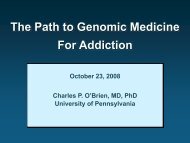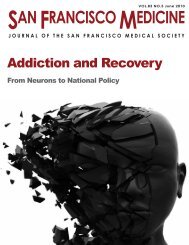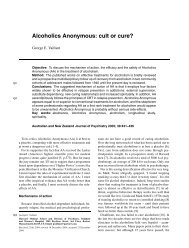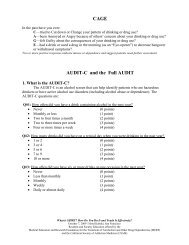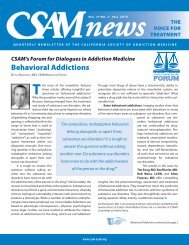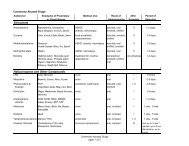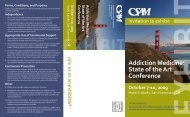Understanding Benzodiazepines
Understanding Benzodiazepines
Understanding Benzodiazepines
Create successful ePaper yourself
Turn your PDF publications into a flip-book with our unique Google optimized e-Paper software.
<strong>Understanding</strong> <strong>Benzodiazepines</strong><br />
Steven M. Juergens MD<br />
Assistant Clinical Professor of<br />
Psychiatry, University of<br />
Washington<br />
Private Practice, Bellevue,<br />
Washington<br />
Steven Juergens MD – Speaker Bureau<br />
Participation<br />
�AstraZeneca – Seroquel (quetiapine)<br />
�Sanofi Aventis – Ambien CR (zolpidem)<br />
�Forest – Lexapro (escitalopram) and<br />
Campral (acamprosate)<br />
�Bristol-Myers Squibb – Abilify<br />
(aripiprazole)<br />
�Wyeth – Effexor XR (venlafaxine)<br />
�Pfizer – Geodon (ziprasidone)<br />
Page 1
Benzodiazepine Use<br />
11% of population use a<br />
benzodiazepine annually<br />
80% for < 4 months<br />
5 % for 4 - 12 months<br />
15% > 12 months ( about 1.6% of<br />
population)<br />
Mellenger et al, JAMA 1984;251:375-379<br />
Gap Between Treatment Guidelines and<br />
Actual Clinical Care<br />
�443 patients with panic disorder in Harvard/Brown<br />
Anxiety Research Project followed prospective over 10<br />
years to examine their use of psychotropic<br />
�Only a modest increase in use of SSRIs over 10 years<br />
was found<br />
�<strong>Benzodiazepines</strong> were the most commonly used<br />
medication for panic disorder and SSRI use has<br />
remained low<br />
�Patients using an SSRI did not have a more favorable<br />
clinical course than those using a benzodiazepine, nor<br />
were there significantly better rates of remission in<br />
patients using SSRIs and benzodiazepines<br />
concomitantly<br />
Bruce et al, Am J Psychiatry,2003;160(8):1432-8<br />
Longitudinal Follow-up Study of Patients with Panic<br />
Disorder 1989-2001 (N=443)<br />
Page 2
<strong>Benzodiazepines</strong><br />
�<strong>Benzodiazepines</strong> all work in<br />
essentially the same way but vary in:<br />
–Dosage<br />
–Rate of onset of action (diazepam<br />
and clorazepate most rapid)<br />
–Duration of action<br />
–Tendency to accumulate<br />
–Potency<br />
Benzodiazepine Receptor<br />
GABA is the major inhibitory<br />
neurotransmitter and it operates in<br />
more than a third of CNS synapses<br />
<strong>Benzodiazepines</strong> enhance synaptic<br />
actions of GABA<br />
Benzodiazepine receptor is an allosteric<br />
recognition site on the GABA<br />
receptors<br />
GABA-Benzodiazepine Receptor Complex<br />
�Pentameric structure compose of 5 distinct<br />
glycoprotein subunits that span a lipid bi-layer and<br />
form a cylindrical structure with a chloride channel as<br />
a center<br />
�Activation causes an influx of chloride ions and<br />
membrane hyperpolarization responsible for neuronal<br />
inhibition<br />
�<strong>Benzodiazepines</strong> do not activate this process but<br />
facilitate the action of GABA by increasing the<br />
frequency of ion channel opening<br />
�Barbiturates and high dose alcohol prolong the<br />
opening<br />
Page 3
GABA-Benzodiazepine Receptor Complex<br />
�Several molecular families of subunits: α with 6<br />
isoforms, β with 3 isoforms, γ with 3 isoforms, θ<br />
with 1 isoform and p with 3 isoforms<br />
�The receptor complex is known to consist of 2 α<br />
subunits alternating with 2 β subunits and a<br />
single γ subunit<br />
�Each receptor complex has 2 GABA binding<br />
sites but only 1 benzodiazepine binding site. The<br />
benzodiazepine binding site is at the intersection<br />
of the pairing of the α and γ subunits<br />
Roy-Byrne, J Clin Psychiatry 2005;66(suppl 2:14-20<br />
α1 and α2 subunits<br />
� α1 subunits mediates<br />
– sedative<br />
– amnesic<br />
– possibly ataxic<br />
– anticonvulsant (to lesser extent)<br />
effects of benzodiazepines (expressed throughout the cerebral<br />
cortex). Majority of benzodiazepine receptors.<br />
� Agents (ie zolpidem) that bind specifically to α1 subunits have<br />
no effects in animals in which the α1 subunit is made to be<br />
insensitive<br />
� α2 subunits involved primarily in antianxiety effects of<br />
benzodiazepines (expressed in hippocampus, amygdala, and<br />
cortex on initial axonal segments of pyramidal neurons)<br />
Weinberger DR (2001) Anxiety at the frontier of molecular medicine. medicine.<br />
New England Journal of<br />
Medicine 344:1247-1249<br />
344:1247 1249<br />
Pharmacodynamics of <strong>Benzodiazepines</strong><br />
Page 4
Benzodiazepine Agonists, Antagonists<br />
and Inverse Agonists<br />
��Agonists Agonists include the benzodiazepines (alprazolam,<br />
diazepam) that increase affinity of GABA for its<br />
receptor, and augment GABA-mediated inhibition.<br />
��Antagonists<br />
Antagonists (such as flumazenil) have no intrinsic<br />
activity, but block the effects of both agonists and<br />
inverse agonists by competitive receptor binding<br />
��Inverse Inverse agonists (such as beta-carboline-3-carboxylic<br />
acid ethyl ester [B-CCE]) have opposite action of the<br />
benzodiazepines, decreasing GABA-mediated chloride<br />
responses, thereby increasing arousal and activation<br />
and promoting seizures by increasing neuronal<br />
excitability<br />
Page 5
Benzodiazepine Pharmacokinetics<br />
Name Dose Onset T 1/2 Metabolism Active substances<br />
Clonazepam 0.25 Inter 18-50 Oxidation Clonazepam<br />
Alprazolam 0.5 Inter 6-20 Oxidation Alprazolam<br />
Lorazepam 1.0 Inter 10-20 Conjugation Lorazepam<br />
Diazepam 5.0 Fast 30-100 Oxidation Diazepam<br />
Desmethyldiazepam<br />
Clorazepate 7.5 Fast 30-100 Oxidation Desmethyldiazepam<br />
Chlordiaze<br />
poxide 10.0 Inter 5-100 Oxidation Chlordiazepoxide<br />
Desmethyldiazepam<br />
Oxazepam 15 Slow 5-12 Conjugation Oxazepam<br />
Benzodiazepine Pharmacokinetics<br />
Metabolism<br />
Glucuronide conjugation - rapid and metabolic<br />
products inactive<br />
Little change with aging<br />
lorazepam, oxazepam, and temazepam<br />
Microsomal oxidation - slow and many metabolic<br />
products active<br />
Significant changes with aging<br />
Under normal circumstances (i.e. excluding<br />
cirrhosis) the metabolic products of alprazolam,<br />
triazolam,and midazolam are of little clinical<br />
importance<br />
Page 6
Biotransformation of<br />
<strong>Benzodiazepines</strong><br />
Benzodiazepine Pharmacokinetics<br />
Oxidatively transformed drugs have longer<br />
half-life and longer duration of action<br />
Diazepam - T1/2 increases from 20 hours<br />
at 20 years to 90 hours at 90 years<br />
Desmethyl diazepam - T1/2 of 51 hours in<br />
young to 151 hours in old<br />
Lorazepam and oxazepam -little change<br />
in T1/2 with age<br />
<strong>Benzodiazepines</strong><br />
Highly lipophilic and rapidly enter the brain tissue<br />
Rate limiting step orally - rapidity of GI absorption<br />
Gastric emptying slowed by food and anticholinergics<br />
Tablets more rapidly absorbed than capsules.<br />
Most benzodiazepines easily cross the blood brain<br />
barrier and placental barrier<br />
IM administration - lorazepam - good<br />
diazepam and chordiazepoxide - unpredictable with<br />
possible precipitation<br />
Intravenous - diazepam, lorazepam or midazolam<br />
Page 7
Common BZP Withdrawal Sx<br />
Symptoms Common in Anxiety<br />
Anxiety Headache Muscle aching<br />
Irritability Tremor, Shakiness Fatigue<br />
Sweating Dizziness Insomnia<br />
Concentration difficulties<br />
Symptoms More Representative of Withdrawal<br />
Nausea, Loss of Appetite<br />
Observable Depression<br />
Depersonalization, Derealization<br />
Increased Sensory Perception (Smell, Light, Taste, Touch)<br />
Abnormal Perception or Sensation of Movement<br />
Delirium<br />
Grand Mal Seizures<br />
Roy-Byrne and Hommer Am J Med 1988<br />
Benzodiazepine Discontinuation<br />
�Withdrawal - “new” time limited<br />
symptoms,not part of the original anxiety<br />
state, that begin and end depending on the<br />
pharmacokinetics of the benzodiazepine<br />
�Relapse - reemergence of the original<br />
anxiety state<br />
�Rebound - increase in anxiety above<br />
original baseline levels that may be a<br />
combination of withdrawal and relapse<br />
Benzodiazepine Withdrawal<br />
�Pharmacologic Variables:<br />
a) higher daily dose of benzodiazepine (or<br />
higher plasma level)<br />
b) short benzodiazepine half-life<br />
c) longer duration of daily benzodiazepine<br />
therapy<br />
d) rapid rate of taper (especially the final<br />
50% of the taper)<br />
e) high potency<br />
(Rickels Rickels et al, J Clin Psychopharm 19(suppl 2):12S-16S 2):12S 16S 1999)<br />
Page 8
Benzodiazepine Withdrawal<br />
�Patient Variables:<br />
a) diagnosis of panic disorder<br />
b) higher pre-taper levels of anxiety and<br />
depression<br />
c) concomitant alcohol and/or substance<br />
dependence or abuse<br />
d) higher levels of personality<br />
psychopathology (e.g. neuroticism,<br />
dependency)<br />
(Rickels Rickels et al, J Clin Psychopharm 19(suppl 2):12S-16S 2):12S 16S 1999)<br />
Benzodiazepine Withdrawal<br />
�Non-pharmacologic variables contribute almost<br />
as much to withdrawal severity / discontinuation<br />
problems as pharmacologic variables<br />
�Severity of withdrawal experience does not<br />
correlate significantly with the inability of the<br />
patient to taper off the BZP successfully<br />
�Personality disordered patients sensitive to<br />
minor cues of withdrawal symptoms<br />
– drop out in early phases of the BZP taper<br />
(before severe symptoms occur), never giving<br />
taper a chance<br />
(Rickels Rickels et al, J Clin Psychopharm 19(suppl 2):12S-16S, 2):12S 16S, 1999)<br />
Prognosis with Tapering<br />
<strong>Benzodiazepines</strong><br />
�If patients able to taper off BZPs, about 3/4 will<br />
be off BZPs 3 years later<br />
�If taper attempt is unsuccessful, but intake<br />
reduced by 50%, only 39% are without a BZP 3<br />
years later<br />
�If patients refused a taper program, all but 14%<br />
used BZPs daily<br />
�Patients who remained off BZPs for 3 years had<br />
a significantly lower level of anxiety and<br />
depression compared with patients continuing<br />
on BZPs over the 3 years<br />
(Rickels Rickels et al, Am J Psych 148:757-761 148:757 761 1991)<br />
Page 9
<strong>Benzodiazepines</strong>: Severity of Withdrawal<br />
Most severe - quickly eliminated, high potency<br />
BZPs (alprazolam, lorazepam, triazolam)<br />
Intermediate severity - quickly eliminated, low<br />
potency BZPs (oxazepam) or slowly eliminated<br />
high potency BZPs (clonazepam)<br />
Mildest severity - slowly eliminated, low potency<br />
BZPs (diazepam, clorazepate, chlordiazepoxide)<br />
Wolf and Griffiths: Drug and Alcohol Dependence 1991<br />
Benzodiazepine Detoxification<br />
Gradual taper of primary sedative drug with more rapid<br />
taper first 50% of dose and more slowly for each<br />
successive 25%<br />
Clonazepam taper for short-acting benzodiazepines<br />
Transfer to long-acting barbiturate (diazepam 10mg =<br />
phenobarb 30 mg) and then reduce by phenobarb 30<br />
mg per day<br />
Carbamazepine 200-800mg daily (or valproic acid 250<br />
mg tid) + BZP for 1-2 weeks and then taper BZP over<br />
4 weeks; continue anticonvulsant alone for 2-4 weeks<br />
Cognitive behavioral therapy significantly increases<br />
success rate<br />
Components of Memory<br />
Acquisition: Information enters via sensory<br />
route<br />
Retention (short - term memory): The<br />
information is of interest and draws<br />
attention<br />
Consolidation: Information of interest is<br />
transferred to long - term memory<br />
Retrieval: Consolidation in reverse; the<br />
obtaining of a memory from long - term<br />
storage<br />
Page 10
Benzodiazipines and Memory<br />
�Types<br />
Short term memory<br />
Semantic memory - information that<br />
is independent of context learned i.e.<br />
use / memory of words<br />
Episodic memory - sequence of events<br />
<strong>Benzodiazepines</strong> and Memory<br />
Impair consolidation of memory and episodic memory<br />
Anterograde amnesia (memory loss after drug has been<br />
taken) with IV administration and short half - life, high<br />
potency BZPs<br />
Do not affect recall of information learned before drug<br />
taken<br />
Elderly most sensitive<br />
With discontinuation, middle-aged and elderly report<br />
improved memory and testing improves<br />
Amnesic effects enhanced by alcohol<br />
Psychomotor Performance and BZPs<br />
Impaired cognitive and neuromotor functioning<br />
with acute and chronic dosing, though results<br />
more inconsistent with long term use<br />
Decreased psychomotor speed<br />
Impaired coordination - ataxia<br />
Decreased sustained attention<br />
Increased effects with:<br />
Increased age Increased dose<br />
Peak levels Alcohol<br />
Page 11
Cognitive Effects of Long-Term Use of<br />
<strong>Benzodiazepines</strong><br />
�Meta analysis of 13 research studies between<br />
1980 and 2000 employing neuropsychological<br />
tests in long term users of benzodiazepines<br />
�Duration of use was from 1 – 34 years (mean 9.9<br />
yrs) with average dose equivalency of 17.2<br />
mg/day of diazepam<br />
�Long term benzodiazepine users were<br />
consistently more impaired than controls across<br />
all cognitive categories examined<br />
�Significant limitations of data present<br />
Barker et al, CNS Drugs 2004;18:37-48<br />
Cognitive Effects of Long-Term Use of<br />
<strong>Benzodiazepines</strong><br />
Page 12
Persistence of Cognitive Effects after Withdrawal<br />
from Long-Term Benzodiazepine Use<br />
�Barker et al meta-analysis of same (12/13)<br />
studies. Average post-withdrawal follow-up<br />
assessment at 3 months<br />
�Improvement in all areas of cognitive function<br />
�Improvement never rises to the level of cognitive<br />
performance of non-benzodiazepine-using<br />
controls<br />
�Potential of permanent cognitive defects or may<br />
take months to improve. Data not conclusive.<br />
Barker et al, Arch Clin Neuropsychol 2004;19:107-113<br />
Persistence of Cognitive Effects after Withdrawal<br />
from Long-Term Benzodiazepine Use<br />
<strong>Benzodiazepines</strong> and Driving<br />
�<strong>Benzodiazepines</strong> impair skills of importance to<br />
driving.<br />
�There is epidemiologic evidence of an increased<br />
risk of crash involvement in younger and older<br />
benzodiazepine users<br />
�In older users, the annual rate of involvement in<br />
injurious crashes is up to 1.5 to 2 times higher<br />
than nonusers and increases as a function of the<br />
prescribed dose<br />
�Long half life benzodiazepines are implicated<br />
most often<br />
Page 13
Falls and <strong>Benzodiazepines</strong><br />
�In older people use of long and short-half life BZPs increase<br />
the risk for falls and femur fracture<br />
(Herings Herings et al, Arch Int Med, 1995; Leipzig et al, J Am Ger Soc, 1999)<br />
�Risk of falling leading to femur fracture is dose dependent,<br />
irrespective of half-life or type of use (intermittent or<br />
continuous)<br />
�High relative risk among patients:<br />
– prescribed benzodiazepines for the first time<br />
– continually exposed whose dose was increased<br />
– concomitantly using several benzodiazepines<br />
(Herings Herings et al, Arch Int Med, 1995)<br />
�Short half-life BZPs have significant psychomotor effects in<br />
first few hours after administration in older patients:<br />
– increased falls if get out of bed for any reason<br />
Depression and Anxiety in Chronic<br />
Benzodiazepine Users<br />
�Significant anxiety and depressive psychopathology<br />
remains in many long-term benzodiazepine users<br />
�If withdrawn successfully from long term<br />
benzodiazepine treatment:<br />
– lower levels of anxiety and depression compared to<br />
pre-taper baseline implying benzodiazepines may<br />
worsen depression and anxiety long-term.<br />
(Schweizer Schweizer et al, Arch Gen Psychiatry, 1990; Rickels et al, J Clin Psychopharm 1999)<br />
�Depression and inter-dose anxiety have been noted to<br />
emerge with benzodiazepine therapy<br />
�Deterioration in mood and social behavior in subjects<br />
on benzodiazepines noted by raters but not subjects<br />
themselves (Griffiths et al, Arch Gen Psychiatry, 1983)<br />
Page 14
Suicide/Death and <strong>Benzodiazepines</strong><br />
�Though safer than barbiturates, there can<br />
be completed suicides with overdoses of<br />
benzodiazepines alone, though most often<br />
combined with alcohol or other drugs<br />
(Drummer and Ransom, Am J Forensic Med and Path, 1996, Ekkedahl et al, Acta<br />
Scan Psych, 1994; Serfaty & Masterton, Masterton,<br />
Br J Psych, 1993)<br />
�In opiate addicts, deaths linked to use of<br />
buprenorphine/heroin and<br />
benzodiazepines, most likely related to<br />
respiratory depression<br />
(Reynaud M et al, Addiction, 1998)<br />
<strong>Benzodiazepines</strong> and Respiratory<br />
Function<br />
�Benzodiazepine use is risk factor for pulmonary<br />
aspiration in neurologically impaired long-term<br />
care patients<br />
(Pick et al, J Am er Soc, 1996)<br />
�Aspiration, as well as respiratory depression<br />
may be a cause of death in benzodiazepine<br />
overdoses<br />
(Drummer and Ranson, Ranson,<br />
Am J Forensic Med Path, 1996)<br />
�<strong>Benzodiazepines</strong> contraindicated in patients<br />
with sleep apnea or significant respiratory<br />
disease because of risk of respiratory depression<br />
Victemization and <strong>Benzodiazepines</strong><br />
�Robbery and sexual assault (including ‘date-rape’)<br />
have been associated with the involuntary and<br />
voluntary use of benzodiazepines, often with use of<br />
other drugs or alcohol<br />
(Boussairi et al, Clin Tox, 1996, Calhoun et al, J Psychoactive Drugs, 1996)<br />
�Flunitrazepam (Rohypnol):<br />
– rapid onset, intermediate acting, highly potent (10<br />
times more potent than diazepam) hypnotic BZP<br />
– never been marketed in the United States but has<br />
been smuggled in the country<br />
– noted for abuse/alleged use to facilitate ‘date rape’<br />
– not clear it poses greater public health risk than<br />
other benzodiazepines<br />
(Woods,J Clin Pharm, 1998) (Simmons and Cupp, Ann Pharmacotherapy, Pharmacotherapy,<br />
1998)<br />
Page 15
<strong>Benzodiazepines</strong> and Pregnancy<br />
�A syndrome of dysmorphic features, growth<br />
aberrations, and abnormalities of the central nervous<br />
system reported in infants exposed to benzodiazepines<br />
during pregnancy (Laegreid Laegreid et al, J Peds, Peds,<br />
1989;<br />
Laegreid et al, Dev Med Child Neurol;1990)<br />
�Lower birth weight in babies with maternal use of<br />
benzodiazepines has been reported.<br />
(Laegreid Laegreid et al, Neuropediatrics, Neuropediatrics,<br />
1992)<br />
�However these findings have not been confirmed by<br />
others and alternative causes for these abnormalities<br />
have been suggested.<br />
(Dolovich Dolovich et al, 1998)<br />
�Sedation and withdrawal has been shown in infants of<br />
mothers taking benzodiazepines up to term<br />
(Bergman et al, Lancet, 1992; Laegreid et al, Neuropediatrics,1992)<br />
<strong>Benzodiazepines</strong> Use in Pregnancy and<br />
Major Malformations or Oral Cleft<br />
�Meta-analysis of studies from 1966 to present,<br />
23 studies included with first trimester exposure<br />
�Analysis of cohort studies showed fetal exposure<br />
to benzodiazepines was not associated with<br />
major malformations<br />
�Analysis of case-control studies showed a small<br />
association between exposure to benzodiazepines<br />
and development of major malformations or<br />
oral cleft alone<br />
�Recommended level 2 ultrasonography should<br />
be used to rule out visible forms of cleft lip<br />
Dolovich et al, BMJ; 1998, 317:839-843<br />
Page 16
Reinforcement and <strong>Benzodiazepines</strong><br />
�<strong>Benzodiazepines</strong> are reinforcers in:<br />
– subjects with histories of drug abuse<br />
– subjects with histories of moderate social alcohol<br />
drinking<br />
– subjects with a history of low frequency<br />
“recreational” drug use that does not meet the<br />
diagnostic criteria for abuse and dependence<br />
– abstinent alcoholics and children of alcoholics have<br />
reinforcing responses to benzodiazepines<br />
– anxious and insomniac subjects<br />
�Not reinforcing in normal subjects without histories of<br />
moderate drinking, anxiety or insomnia<br />
<strong>Benzodiazepines</strong> and the Alcoholic<br />
(Librium) “During the<br />
rehabilitation<br />
period…strengthens<br />
the physician patient<br />
relationship…Librium<br />
therapy helps reduce<br />
the patients need for<br />
alcohol by affording a<br />
constructive approach<br />
to his underlying<br />
personality disorders”<br />
Rates of Benzodiazepine Abuse<br />
Clinical and descriptive data regarding benzodiazepine<br />
addiction are surprisingly inadequate.<br />
Population Prevalence (%)<br />
General Population Unknown<br />
Alcohol Abusers 30-75<br />
Opiate Abusers Up to 80<br />
Inpatient Drug Abusers<br />
Isolated BZP Abusers 12<br />
Poly Drug Dependent 80<br />
Page 17
Patterns of Benzodiazepine Abuse<br />
Inappropriate chronic use by patients<br />
Older<br />
Lower daily doses<br />
More withdrawal symptoms<br />
Polydrug abuse<br />
Younger<br />
Higher daily doses<br />
More escalation of dose<br />
<strong>Benzodiazepines</strong> - Uses<br />
�Psychiatric disorders - mainly<br />
anxiety, panic and agitation<br />
�Anticonvulsant<br />
�Muscle relaxant properties<br />
�Alcohol withdrawal<br />
Chronic Benzodiazepine Use<br />
�Use reevaluated at regular intervals :<br />
–diagnosis correct?<br />
–distress and disability warrant use?<br />
–benzodiazepine providing a positive<br />
therapeutic response, with appropriate doses?<br />
–any other drug or alcohol addiction?<br />
–evidence of any BZP-induced adverse effects?<br />
–family member / significant other confirm<br />
effectiveness of BZP use and lack of<br />
impairment or addiction?<br />
DuPont RL (1990). A practical approach to benzodiazepine discontinuation. discontinuation.<br />
Journal of Psychiatric Research 24:81- 24:81<br />
90.<br />
Page 18
Generic<br />
Name<br />
Zaleplon<br />
Zolpidem<br />
tartrate<br />
Zaleplon, Zolpidem and Eszopiclone<br />
Classification<br />
pyrazolopyrimidine<br />
imadozopyridine<br />
Eszopiclone Pyrrolopyrazine<br />
dirivative of<br />
cyclopyrrolone<br />
class<br />
Zolpidem imadozopyridine<br />
tartrate<br />
extended<br />
release<br />
Adult<br />
Dose<br />
10 mg,<br />
20 mg<br />
10 mg<br />
2 mg,<br />
3 mg<br />
12.5 mg<br />
Elderly<br />
Dose<br />
5 mg<br />
5 mg<br />
1 mg<br />
6.25 mg<br />
1 hr<br />
T ½<br />
2.5 hr,<br />
2.9 hr in<br />
elderly<br />
6 hr,<br />
9 hr in<br />
elderly<br />
2.8 hr,<br />
2.9 hr in<br />
elderly<br />
T max<br />
1 hr<br />
1.6 hr<br />
1.0 hr<br />
1.5 hr,<br />
2.0 hr in<br />
elderly<br />
Zaleplon, Zolpidem and Eszopiclone<br />
�Zolpidem and Zaleplon<br />
– actions are mediated at the alpha-1 benzodiazepine<br />
receptor subtype<br />
– CYP3A4 has been reported to play an important<br />
role in metabolism of zolpidem and zaleplon<br />
�Eszopiclone - [(S)-zopiclone] is the active enantiomer of<br />
racemic zopiclone [(R,S) zopiclone]<br />
– Exact MOA unknown, but believed to be due to its<br />
interaction with an allosteric modulation of the<br />
GABA-A receptor complex<br />
– Active metabolite has low potency<br />
– Unpleasant taste (34%) with 3 mg dose<br />
Page 19
Zolpidem, Zaleplon and Eszopiclone<br />
�Like BZPs, zolpidem, zaleplon and<br />
eszopiclone classified as Schedule IV<br />
controlled substances by DEA<br />
�Zaleplon, zolpidem and eszopiclone<br />
decrease sleep latency with little effect on<br />
sleep stages<br />
– BZPs decrease sleep latency, prolong the<br />
first two stages of sleep and shorten<br />
stages 3 and 4 (deep sleep) and REM<br />
sleep<br />
Ramelteon<br />
�Selective MT1/MT2 receptor agonist<br />
�Negligible affinity for GABA-A receptor complex<br />
�1/2 Life = 1-2.6 hours<br />
�More than 17 times more potent than melatonin<br />
�No known abuse liability<br />
�Metabolized by CYP 1A2 with minimal involvement of<br />
CYP 2C9 and 3A4<br />
�Should not be used with fluvoxamine<br />
�8 mg dosage strength<br />
�Not scheduled as a controlled substance by FDA<br />
Abuse Potential of Zolpidem, Zaleplon and<br />
Eszopiclone<br />
�Evidence is mixed regarding abuse potential of the<br />
zaleplon, zolpidem and zopiclone.<br />
�Some studies showing comparable drug liking,<br />
reinforcing effects and decrements on performance<br />
tests depending on dose and time tested compared to<br />
benzodiazepines and some showing less abuse<br />
potenttial compared to benzodiazepines<br />
�There are case reports of abuse and withdrawal from<br />
zolpidem and zopiclone<br />
�Based on prescription numbers, reported dependence<br />
for zopiclone and zolpidem is “remarkably lower” than<br />
that of benzodiazepines used for insomnia<br />
Hajak et al, Addiction. 2003 Oct;98(10):1371-8<br />
Page 20
Barbiturate and Barbiturate-Like<br />
Drugs<br />
�Except for the anticonvulsant actions of<br />
phenobarbital and its congeners, the<br />
barbiturates and other barbiturate-like<br />
sedative-hypnotics (with the partial exception of<br />
meprobamate) have similar properties<br />
�The withdrawal syndrome following chronic use<br />
can be severe and life threatening<br />
�Low therapeutic index and low degree of<br />
selectivity<br />
–therapeutic effect of sedation / anxiolysis<br />
accompanied by CNS depression<br />
Barbiturate and Barbiturate-Like<br />
Drugs<br />
�Other disadvantages compared to the<br />
benzodiazepines :<br />
–induce hepatic enzymes (more drug<br />
interactions) i.e. oral contraceptives<br />
–produce more tolerance, impairment and<br />
toxicity<br />
–greater liability for development of abuse and<br />
dependence<br />
–more dangerous in overdose; acute<br />
intoxication produces respiratory depression<br />
and hypotension<br />
Barbiturates<br />
�Pentobarbital, secobarbital, and butabarbital are used<br />
as sedatives and butalbital is marketed in combination<br />
with analgesic agents<br />
– classified as short to intermediate acting<br />
barbiturates<br />
» half-life of these drugs (from 15-80 hours)<br />
» will accumulate during repetitive administration<br />
�Phenobarbital - long acting barbiturate (half-life 80-<br />
120 hours) used predominately for treatment of seizure<br />
disorders, abuse is relatively uncommon<br />
�Ultra-short–acting agents (thiopental or methohexital)<br />
are employed as anesthetics<br />
Page 21
Glutethemide<br />
�Pharmacology is like the barbiturates but it also<br />
exhibits pronounced anticholinergic activity<br />
�Erratically absorbed<br />
�In acute intoxication the symptoms are similar to<br />
barbiturate poisoning with somewhat less severe<br />
respiratory depression<br />
– Antimuscarinic actions cause xerostomia, ileus,<br />
urinary bladder atony, long-lasting mydriasis and<br />
hyperpyrexia, which can persist for hours after the<br />
patient has regained consciousness<br />
– In some cases there can be tonic muscle spasms,<br />
twitching and even convulsions<br />
Chloral Hydrate<br />
�Rapidly reduced to the active compound,<br />
trichloroethanol, largely by hepatic alcohol<br />
dehydrogenase.<br />
�Trichlorethanol conjugated with glucuronic acid and<br />
excreted mostly into the urine.<br />
�The plasma half-life is 4 to 12 hours.<br />
�Trichlorethanol exerts barbiturate-like effects on<br />
GABA A receptor channel.<br />
�Chloral hydrate is irritating to the skin and mucous<br />
membranes<br />
– causes unpleasant taste, epigastric distress, nausea,<br />
and occasional vomiting, especially if the drug is<br />
insufficiently diluted or taken on an empty stomach<br />
Chloral Hydrate<br />
�Choral hydrate and alcohol in<br />
combination is the “Mickey Finn”<br />
�Overdose effects resemble acute<br />
barbiturate intoxication, although may<br />
have icterus.<br />
�Chronic users may exhibit sudden acute<br />
intoxication, which can be fatal; this<br />
results either from an overdose or from a<br />
failure of the detoxification mechanism<br />
secondary to hepatic damage<br />
Page 22
Meprobamate<br />
�Important aspect of intoxication with<br />
meprobamate is formation of gastric<br />
bezoars consisting of undissolved<br />
meprobamate tablets - treatment may<br />
require endoscopy and mechanical<br />
removal of the bezoar<br />
�Carisprodol (SOMA) - Skeletal muscle<br />
relaxant whose active metabolite is<br />
meprobamate, also has abuse potential and<br />
is a ‘street drug’<br />
Additional Slides for Your<br />
Perusal<br />
I thought you might use these to study.<br />
Good luck!<br />
Page 23
Benzodiazepine Structure<br />
�The core structure of benzodiazepines consists<br />
of a benzene ring fused to a seven-membered<br />
1,4 diazepine ring thus their name<br />
�Almost all also have a 5-aryl substituent ring<br />
�They differ from one another in the chemical<br />
nature of the substituent groups at positions<br />
1,2,3, and 4 (of the diazepine ring), position 7<br />
(of the benzene ring, and position 2’(of the 5aryl<br />
substituent ring)<br />
Absorption of <strong>Benzodiazepines</strong><br />
� Highly lipophilic and rapidly enter the brain tissue<br />
� Rate limiting step in oral dosing - rapidity of absorption from<br />
the GI tract.<br />
� Gastric emptying slowed by anticholinergic agents and food.<br />
� Tablets are more rapidly absorbed than capsules.<br />
� Rapidly absorbed benzodiazepines (diazepam) produce more<br />
euphoria / more reinforcing<br />
� Slower absorbed drugs (oxazepam, temazepam) have longer<br />
latency period, will produce a lower peak, perceived as less<br />
intense and more gradual.<br />
� May be modified by gastric acid to affect absorption (ie<br />
clorazepate is prodrug modified by acid hydrolysis in the<br />
stomach to form desmethyldiazepam, then absorbed with a fast<br />
onset of action).<br />
� Only lorazepam available for sublingual administration but<br />
absorption rate not different from oral administration<br />
Page 24
Benzodiazepine Absorption<br />
�Chlordiazepoxide, diazepam, lorazepam and<br />
midazolam are formulated to be administered IM<br />
�Chlordiazepoxide may precipitate locally and is slowly<br />
and poorly absorbed<br />
�Diazepam is absorbed in a variable and unpredictable<br />
manner<br />
�There is little experience with midazolam except for<br />
preanaesthetic use<br />
�The rates of absorption and peak plasma levels with IM<br />
lorazepam and midazolam are higher than for oral<br />
administration<br />
Five Types of <strong>Benzodiazepines</strong><br />
a) 2-keto compounds (clorazepate, chlordiazepoxide,<br />
diazepam, halazepam, prazepam, flurazepam).<br />
Metabolized to desmethyldiazepam. Oxidized in<br />
the liver before conjugated and tend to have long<br />
half-lives as desmethyldiazepam has a 30-200 hour<br />
half-life, with the length increasing with age<br />
b) 3-hydroxy compounds (lorazepam, oxazepam,<br />
temazepam). Active compounds with shorter halflives,<br />
rapidly metabolized by direct conjugation<br />
with a glucuronide radical and do not generate<br />
active metabolites. Age, drug interactions or liver<br />
function does not affect the metabolism.<br />
Five Types of <strong>Benzodiazepines</strong><br />
c) Triazolo (alprazolam, triazolam, estazolam) and<br />
d) imidazo (midazolam) compounds have short half<br />
lives, transformed into hydroxylated compounds<br />
prior to conjugation, but these hydroxylated<br />
intermediates, although quite active, are conjugated<br />
rapidly and do not accumulate<br />
e) 7-nitro compounds (clonazepam) which are<br />
active, have long half-lives, no active metabolites,<br />
and are metabolized by nitroreduction.<br />
Page 25
Drug Interactions<br />
� BZPs have additive CNS effects with other sedative drugs<br />
� The metabolism of BZPs (except the 3 hydroxy compounds) is<br />
mainly catalysed by CYP3A3/4 isoenzyme - impaired in old age<br />
and significant hepatic dysfunction<br />
� Diazepam, at high concentrations, is catalysed by CYP3A3/4 and<br />
at low concentrations CYP2C19 is mainly involved<br />
� Specific SSRIs, nefazodone, the antimycotics ketoconazole and<br />
intraconazole, macrolide antibiotics such as erythromycin,<br />
cimetidine, omeprazole, ritonavir, grapefruit juice may all<br />
inhibit CYP3A4 and increase BZP levels<br />
� Re the SSRIs, paroxetine and citalopram unlikely to cause<br />
interactions with benzodiazepines and sertraline inhibits these<br />
enzymes only mildly to moderately at usual therapeutic doses so<br />
the potential for interaction is low<br />
Endogenous <strong>Benzodiazepines</strong> and<br />
“Endozepines”<br />
�Endogenous benzodiazepines such as diazepam and<br />
nordiazepam as well as other benzodiazepine-like<br />
compounds termed ‘endozepines’, which are not<br />
halogenated, have been found in human blood and<br />
brain<br />
�They are present in only trace amounts but are<br />
increased in patients with cirrhosis and may be a factor<br />
in hepatic encephalopathy<br />
�The source is unknown but they are in vegetables and<br />
medicinal plants, such as in camomile or may be<br />
synthesized by intestinal bacteria<br />
Baraldi M, Avallone R, Corsi L et al (2000) Endogenous benzodiazepines.<br />
benzodiazepines.<br />
Therapie<br />
55:143-146 55:143 146<br />
Barbiturates, Alcohol and Toxicity<br />
� Barbiturates also are positive modulators of GABA A receptors<br />
– bind to undefined site on the GABA complex<br />
– interact with GABA in a concentration dependent manner<br />
distinct from benzodiazepines<br />
� Alcohol also potentiates GABA on receptors with the g2 subunit,<br />
increasing the flow of chloride ions, causing sedation and<br />
psychomotor problems.<br />
� At higher concentrations (>250 mg/dl) alcohol has a direct action<br />
on the receptor causing a prolonged opening of the chloride<br />
channel that is GABA independent.<br />
� This prolonged opening is also true for barbiturates but not<br />
benzodiazepines.<br />
� This explains why alcohol and barbiturates are much more toxic<br />
in overdose - the chloride influx may result in paralysis of the<br />
neurons responsible for respiratory drive. for respiratory drive.<br />
(Nutt, Br J Psychiatry 1999)<br />
Page 26
Tolerance Testing<br />
�High or erratic dose, illicit source, polysubstance<br />
or alcohol plus benzodiazepine use.<br />
�In 24-hour medically monitored setting<br />
�200 mg pentobarbital PO Q 2h - hold for<br />
intoxication, slurred speech, ataxia, somnolence.<br />
�After 24-48 hrs, calculate 24 hr stabilizing dose<br />
�Give stabilizing dose for 24 hrs divided<br />
�Switch to phenobarbital (30mg = 100mg<br />
pentobarbital)<br />
�Initiate gradual taper<br />
Patterns of Problematic<br />
Benzodiazepine Use<br />
�The “recreational” abuser:<br />
– uses benzodiazepines to become intoxicated<br />
in an intermittent or chronic pattern of high<br />
doses<br />
–pattern often one of poly-drug abuse.<br />
–source of the drug is often illicit<br />
–incidence is relatively rare relative to the rate<br />
of widespread legitimate medical use, but<br />
similar to abuse of other illicit substances such<br />
as opioids or cocaine.<br />
Patterns of Problematic<br />
Benzodiazepine Use<br />
�The chronic quasi-therapeutic user:<br />
– often older<br />
– may or may not have a history of alcohol or drug<br />
abuse or may have a chronic pain problem<br />
– motive for use is “symptom” treatment<br />
– many may report unsuccessful efforts to cut down<br />
use and use to relieve or avoid withdrawal<br />
– incidence of this quasi-therapeutic use unknown but<br />
estimated to be relatively prevalent to the rate of<br />
prescription of benzodiazepines usually therapeutic<br />
doses are used<br />
– source of the drug is usually licit though may involve<br />
deception to obtain the drug (e.g. multiple<br />
physicians)<br />
Page 27
<strong>Benzodiazepines</strong>: Addiction Liability<br />
�<strong>Benzodiazepines</strong> are less reinforcing and have a lower<br />
abuse potential than several barbiturates (amobarbital,<br />
pentobarbital, secobarbital ) and older generation<br />
sedative/hypnotics (glutethimide, meprobamate,<br />
methaqualone).<br />
�<strong>Benzodiazepines</strong> vary in abuse liability based on<br />
differential subjective effects.<br />
– Diazepam, lorazepam, triazolam, flunitrazepam and<br />
alprazolam have relatively high abuse liability, while<br />
oxazepam, halazepam, clorazepate, prazepam and<br />
chlordiazepoxide do not.<br />
– The speed of onset of pleasurable effects is an<br />
important factor in addiction potential<br />
Benzodiazepine Addiction<br />
�Clinical and descriptive data regarding benzodiazepine<br />
addiction are surprisingly inadequate.<br />
�Reports document populations of benzodiazepineaddicted<br />
patients, largely from hospitals and addiction<br />
treatment centers (Busto et al, J Clin Psychopharm 1996, Finlayson &<br />
Davis, Mayo Clin Proc, 1994)<br />
�A high prevalence (40% or more) of benzodiazepine<br />
dependence in outpatient users of benzodiazepines has<br />
been noted in a Dutch study (Kan et al,Acta Psych Scan, 1997)<br />
�Survey data give evidence of large number of persons<br />
engaged in long-term use of benzodiazepines, and a<br />
significant amount of abuse/non-medical use, but<br />
difficult to translate that into estimates of addiction<br />
(Griffiths and Weerts, Psychopharm, 1997)<br />
<strong>Benzodiazepines</strong> and Addiction<br />
�194 pts with long-term BZP use in a German university<br />
clinic<br />
�Daily intake began immediately after the first Rx in<br />
80%<br />
�34% reported daily dose of 30 mg diazepam per day<br />
�70% had additional abuse of alcohol and/or other<br />
drugs<br />
�BZPs were the first substances abused in 49%<br />
�30% had dx of organic brain syndrome at some point<br />
�During use of BZPs, patients somatic complaints,<br />
depressed mood and anxiety increased and after<br />
detoxification symptoms improved in 80%<br />
Luderer et al, Psychiatr Prax:2/6; (231-234), 1995<br />
Page 28
Buprenorphine and <strong>Benzodiazepines</strong><br />
� Benzodiazepine use with buprenorphine is a “relative<br />
contraindication”<br />
– 20 deaths, all but one had benzodiazepines (Tacqui et al J Anal<br />
Toxicol, 1998 Oct;22:430-44)<br />
– 2 series of 39 and 78 deaths in buprenorphine patients (Kintz,<br />
Forensic Sci Int. 2001 Sep 15:121:65-69)<br />
» None buprenorphine alone<br />
» 79.5%in one series and 76.9% in the other also had<br />
benzodiazepines<br />
– 13 deaths in buprenorphine patients (Kintz, Clin Bichem. 2002<br />
Oct;35:513-6)<br />
�None had buprenorphine alone<br />
�<strong>Benzodiazepines</strong> in 9 cases<br />
�All were large dose illicit use, ½ IV illicit use<br />
<strong>Benzodiazepines</strong> – Psychiatric Uses<br />
� Generalized Anxiety Disorder<br />
� Adjustment Disorder with Anxiety<br />
� Anxiety in the Medically Ill<br />
� Panic Disorder<br />
� Social Phobia<br />
� Premenstrual Dysphoric Disorder<br />
� Obsessive Compulsive Disorder - primary rx and augmentation<br />
� Schizophrenia and Other Psychosis – augmentation / agitation<br />
� Depressive Disorders - augmentation<br />
� Bipolar Disorder - augmentation<br />
� Movement Disorders - Akathesia, Catatonia/Rigidity<br />
� Insomnia and Other Sleep Disorders<br />
� Alcohol Withdrawal<br />
Early Coadministration of Clonazepam<br />
with Sertraline for Panic Disorder<br />
� 50 pts with panic disorder randomized to double-blind trial. All received sertraline<br />
for 12 weeks with target dose of 100 mg and randomized to receiving either<br />
clonazepam 0.5 mg tid or placebo for 4 weeks then tapered over 3 weeks<br />
� Goddard et al, Arch Gen Psychiatry, 2001;58:681-86<br />
Page 29
Barbiturates and Alcohol and the GABA<br />
Receptor<br />
1. Barbiturates exert their effect by enhancing<br />
GABA receptor binding and prolonging the<br />
opening of Cl channels.<br />
2. In higher doses, barbiturates may act directly<br />
on the chloride channel without GABA.<br />
3. At higher concentrations (>250 mg/dl) alcohol<br />
has a direct action on the receptor causing a<br />
prolonged opening of the chloride channel that<br />
is GABA independent.<br />
Zaleplon and Zolpidem<br />
� Zolpidem (Ambien and Ambien CR), an imadozopyridine, and<br />
Zaleplon (Sonata), a pyrazolopyrimidine, are nonbenzodiazepine<br />
hypnotics with rapid onset (within 1 hour), short<br />
duration of action, and short half-lives (zolpidem: 2.4 hours and<br />
zaleplon: 1 hour)<br />
� Their actions are mediated at the omega-1 benzodiazepine<br />
receptor subtype<br />
� Both have a dosage range of 5 to 20 mg with 5 mg being the<br />
starting dose in the elderly or the medically ill<br />
� Both seem relatively safe in the elderly, especially compared to<br />
longer acting benzodiazepine hypnotics<br />
� Both extensively metabolized in the liver, eliminated by renal<br />
excretion and have no active metabolites<br />
� Both potentiate psychomotor impairment with alcohol<br />
Eszopiclone<br />
� Nonbenzodiazepine hypnotic, pyrrolopyrazine derivative<br />
derivative of the cyclopyrrolone class, binds to GABA receptors<br />
but exact mechanism of action unknown<br />
� Dose:1-3 mg<br />
� Little withdrawal and may not lose effectiveness over 6 months<br />
of use.<br />
� High fat and heavy meal may reduce effect of eszopiclone on<br />
sleep onset<br />
� Subjects 65 years and older had an increase of 41% in total<br />
exposure and slightly prolonged elimination of eszopiclone with<br />
T ½ of 9 hours<br />
� If there is severe liver impairment, the exposure was increased 2fold<br />
and t ½ was not changed<br />
� Unpleasant taste (34%) with 3 mg dose<br />
Page 30
Abuse Potential of Zaleplon<br />
�Zaleplon at high doses (25, 50 and 75 mg),<br />
triazolam (0.25, 0.5, and 0.75 mg and placebo<br />
were compared for abuse potential and<br />
behavioral effects<br />
�Zaleplon and triazolam produced comparable<br />
dose-dependent decrements on several<br />
performance tasks<br />
�Subject rated measures that reflect abuse<br />
potential (e.g. drug liking, good effects and<br />
monetary street value) suggested that zaleplon<br />
and triazolam were comparable<br />
(Rush CR, Frey JM, Griffiths RR (1999) Zaleplon and triazolam in humans: acute<br />
behavioral effects and abuse potential. Psychopharmacology 145:39-51 145:3 51<br />
Abuse and Dependence Potential for<br />
Zolpidem and Zopiclone<br />
�Medline search from 1966 to 2002<br />
�36 cases for zolpidem and 22 cases for zopiclone<br />
abuse/ dependence<br />
�In extreme cases dose increases reached a factor<br />
of 30 – 120 above recommended doses<br />
�Majority of patients had a history of former<br />
drug or alcohol abuse and/or other psychiatric<br />
conditions<br />
�Based on prescription numbers, reported<br />
dependence similar for both drugs and<br />
“remarkably lower” than that of<br />
benzodiazepines used for insomnia<br />
Hajak et al, Addiction. 2003 Oct;98(10):1371-8<br />
Eszopiclone<br />
�Eszopiclone [(S)-zopiclone] is the active enantiomer<br />
of racemic zopiclone [(R,S) zopiclone]<br />
�Virtually all sedative/hypnotic activity of racemic<br />
zopiclone is attributable to the (S)-isomer<br />
�Exact MOA unknown, but believed to be due to its<br />
interaction with an allosteric modulation of the<br />
GABA-A receptor complex<br />
Page 31
Behavioral Pharmacology of Zolpidem<br />
�Literature suggests that zolpidem similar to<br />
benzodiazepines in terms of its reinforcing effects,<br />
abuse potential, subject-rated effects (in individuals<br />
with and without a histories of drug or ethanol abuse)<br />
�Some evidence to suggest that the tolerance and<br />
dependence-producing effects may be less than those of<br />
benzodiazepines, though paucity of appropriate studies<br />
of the question<br />
Rush CR (1998) Pharm, Pharm,<br />
Biochem and Behav 61:253-269 61:253 269<br />
�There are isolated cases of abuse and withdrawal<br />
symptoms reported with zolpidem<br />
(Cavallaro Cavallaro et al, 1993; Gericke and Ludolph, Ludolph,<br />
1994)<br />
Psychomotor Effects of Zaleplon and<br />
Zolpidem<br />
�Zaleplon 10 mg - no decrements in psychomotor<br />
performance, memory or learning compared with<br />
placebo after 1.25 hours though zolpidem 10 mg and<br />
triazolam 0.25 mg did (Troy et al, 2000, J Clin Psychopharm 20:328<br />
�Zolpidem (compared with temazepam and triazolam)<br />
produces similar impairment of learning, recall, and<br />
performance as well as estimates of drug effects<br />
(Rush & Griffiths, 1996)<br />
�Zolpidem 15 mg impaired coordinative, reactive and<br />
cognitive skills at 1 and 3.5 hours more clearly than<br />
diazepam 15 mg, oxazepam 30 mg, and ethanol<br />
20:328-337) 337)<br />
(Mattila Mattila et al, 1998)<br />
�Zolpidem appears to induce minimal next-day effects<br />
(Darcourt Darcourt et al,1999)<br />
Buspirone (Buspar)<br />
�Azapirone class - 5HT 1A partial agonist<br />
�Does not bind to the BZP - GABA receptor complex<br />
�T 1/2 is 2 - 8 hours<br />
�As efficacious as benzodiazepines for GAD<br />
�“Lag time” of 1 - 2 weeks<br />
�No muscle relaxant or anticonvulsant properties<br />
�Less sedation or psychomotor effects compared to<br />
BZPs<br />
�Abuse potential low and no withdrawal symptoms<br />
�Prior use of BZPs may reduce effectiveness<br />
� Dose : 5 - 10 mg tid<br />
Page 32
Buspirone<br />
� In anxious alcoholics who received weekly relapse<br />
prevention therapy in addition to buspirone found<br />
buspirone superior to placebo in:<br />
– the reduction of anxiety<br />
– the retention in treatment<br />
– the reduction of drinking days in follow-up<br />
– delayed return to heavy drinking<br />
(Kranzler Kranzler et al 1994 Arch Gen Psychiatry 51:720-731) 51:720 731)<br />
� In patients with GAD who had recent history of<br />
benzodiazepine treatment:<br />
– greater discontinuation rates<br />
– more adverse events<br />
– less efficacy<br />
compared to patients treated with buspirone who had no<br />
previous benzodiazepine treatment<br />
(DeMartinis<br />
DeMartinis et al, J Clin Psychiatry 61:91-94 61:91 94<br />
Buspirone in the Rx of Anxiety<br />
Advantage Disadvantage<br />
No sedation No sedation<br />
No withdrawal Gradual onset of effects<br />
No interaction with alcohol Titration of dose<br />
No impaired cognition Multiple daily dosing<br />
No psychomotor effects Lower acceptance by<br />
Well tolerated recent BZP users<br />
Safe in overdose Efficacy questions<br />
Page 33
Page 34




